Reading time: 1 minute
In 2016, the Insitut für Fenstertechnik e.V. (ift Rosenheim) is celebrating its 50th anniversary. According to the motto ‘ift Rosenheim – 50 years of service to the industry’, the technical development is presented in a ten-part series of articles. The individual articles are reflecting timeframes of 5 years from founding of the institute. They enable a short glance at the events at that time, take up as a key aspect a pioneering research project at that time, summarize goals, contents as well as results, then illustrate the further development as well as the impact thereof on the industry, and the current state of the art.
The seventies of the twentieth century were dominated by the oil embargo of the OPEC nations which led to the most serious oil crisis in autumn 1973. Already on 09 November 1973, the German Bundestag passed the Energy Security Act which intended immediate measures to the energy saving among other things. The development of the Institut für Fenstertechnik e.V. (ift Rosenheim) was already linked to the events on the big world stage. It intensified with the development of the area of thermal insulation.
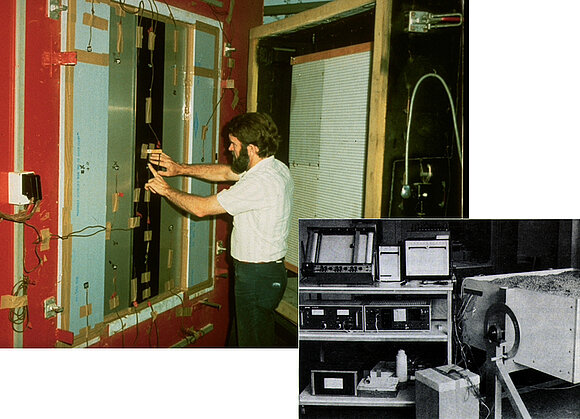
Renovation with focus on thermal insulation
Current situation at the beginning of the 70s
Steadily, the percentage of the window area on the total facade area increased. From the 70s, a percentage of over 50% was not uncommon any more. This affected with other building-physical reasons the heat balance of the buildings. As the price of heating oil was relatively favorably until then, hardly any considerable suggestions for energy conservation have been made. The sudden price increase of 300 % and more for heating oil due to the oil crisis changed the boundary conditions drastically and demanded for rapid action.
Definition of task und aim of the first ift research project with focus on thermal protection
ift Rosenheim was assigned within the research contract ‘Reduction of the Energy Consumption in Apartments’ with editing the section ‘Window’ as well as the section ‘Walls - Windows’ (connection of the window to the wall). The overall project should analyse the influencing factors on which the energy demand in apartments depends. After the determination of the theoretical basics, inspections on properties from 1951 to 1974 should display measure for the reduction of the energy demand.
Results of research projects
Two areas with influence on the energy demand are distinguished in the research report published in 1974:
- directly influenced factors by planning and calculation;
- influenced factors by the workmanship.
The focus is on extensive review of permeability of joints of windows. The measured values display large fluctuations without association between year of construction and height of permeability of joints. The main reasons are in the construction and quality of the inspected window. Moreover, substantial amounts of air enter in the attachment of the wall. The need of actions taking effect, also for the area of old buildings, was given.
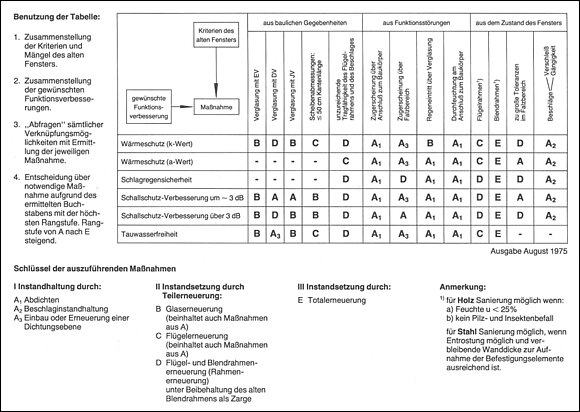
The knowledge gained in the examination enables concrete improvement measures for windows and the definition of quality-related characteristics.
Already soon after, ift Rosenheim presented in the research project ‘Window at Renovation of an Old Building’ a catalogue of measures (Fig. 2) that provides a decision-making tool for which measure are possible, technically correct and therefore economically viable.
The Nucleus for all Other
Leap for the Fenestration Technology and the Quality
In 1977, a legal form was given to the complete knowledge of the energy economy on-site with the first Thermal Insulation Regulation. So, double glazing and a sealant in the rebate between frame and sash were demanded for the first time. Thereby, a dynamic advancement in the fenestration technology regarding construction and assembly began – right down to the details:
- Rebate design with sealants, design of sealing profile and the drainage,
- Further development in hardware technology,
- Application of insulating glass unit,
- Glazing system for insulating glass units (blocking, sealing, rebate design,...),
- Thermal barrier of metal profiles,
- Ventilation equipment for use in windows and facades etc.
By efficient manufacturing and good material properties plastic windows established themselves quickly. The restructuring of residential buildings with largely similar windows complied with this frame material. With the growth and complexity of construction details, the correct fabrication is getting even more important. An appropriate quality control was indispensable.
Assembly in den Wall Opening
Water entering at the mounting of building components has been analysed as substantial cause of damage. As the building shell was not sealed yet, the topic of an interior sealing on the basis of inner moisture levels was not relevant. The recommendations for the sealing referred only to the external tightness.
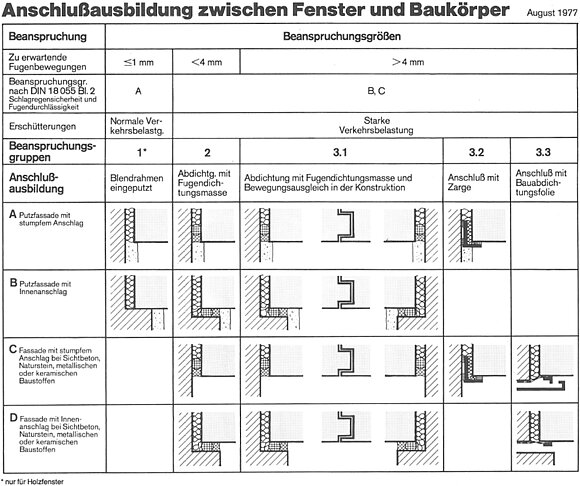
Window in Refurbishment of an Old Building Today
In Germany, the majority of windows are being installed in refurbishment of an old building. Improvements at energy efficiency, security and comfort are decisive factors when deciding on new windows.
A set of regulations that are legally introduced are available for the technical realization. To that belong DIN 4108 (thermal insulation), DIN 4109 (sound insulation), Energy Saving Regulations and DIN 1946-6 (ventilation). Hence, nearly all specifications on assembly, the planned ventilation concept, etc. are bindingly specified. In practice, these specifications for old buildings are almost never completely fulfillable without additional construction measures. The construction of necessary measures to avoid thermal bridge, to implement a ventilation concept, etc. is often not assigned completely. Hence, the restoration remains incomplete and vulnerable regarding problems with condensation and mould (correlations see Fig. 4).
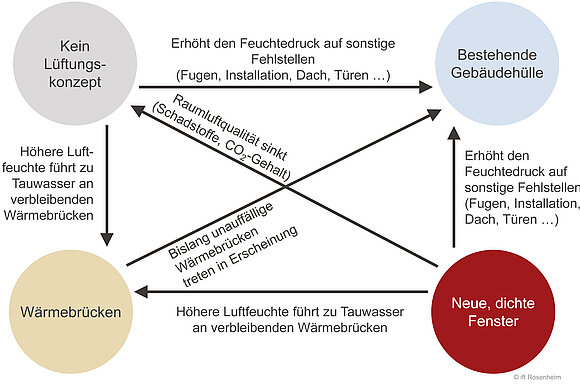
Superficially, the energy economy is the only essential argument for the window refurbishment. However, the real decision for refurbishment is based rather on the correction of defects and deficits on old windows:
- visually noticeable defects on the windows,
- defects of use,
- low comfort level,
- frequent maintenance and maintenance measures.
If the new windows do not fulfill the real motives for the refurbishment, complaints can come up quickly. Characteristics as easy handling, sound insulation or similar are directly noticeable by the user. Something similar counts for defects of non-professional construction. However, the energy economy is only experienced indirectly and time-delayed.
Summary
New windows in old buildings are furthermore a challenge. The window refurbishment has always effects on the building and the user, therefore, the goal of restoration has to be seen in its entirety. An expert advice would be obligatory.
In the meantime, the fenestration technology offers a large range of products that can be adapted to the special requirements. Equipping the windows with ventilation installations, which secure the hygienic necessary basic ventilation (Fig. 5), is no special case anymore.
The selection of the correct window, the analysis and the planning of the correlation regarding ventilation and installation as well as the correct workmanship of critical details are indispensable. Refurbishment only after the motto ‘From Old to New’ can cause new problems whose cause is often seen in the new windows. In reality, the cause lies mostly in the incomplete realization of a concept for refurbishment – also often not existing.
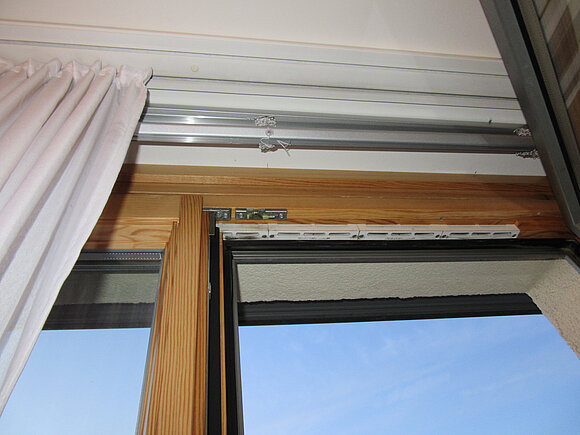
Literature
- 25 years Institut für Fenstertechnik e.V.; An overview.
Institut für Fenstertechnik e.V., Rosenheim 1991 - Froelich, H.; Heine, F.; Menck, R.; Stumpp, E.:
Reduction of the energy consumption in apartments
(thermal insulation and heating systems – improvements at existing house buildings and arrangements at future planning and building);
Chapter: ‘Windows’ and ‘Walls – Windows’.
Research report of Institut für Fenstertechnik e.V., Rosenheim 1974 - Seifert, E.; Daler; R.; Heine, F.:
Windows at renovation of an old building.
Research report of Institut für Fenstertechnik e.V., Rosenheim 1979 - Leuschner, I.:
Renovation projects without rude awakening;
How defects can be avoided.
Newsletter ift infoline 05/2015 - Leuschner, I.:
Reports from ift Centre of Technical Experts:
Comeback of dew point performance? – Assessment of the current situation.
Newsletter ift impulse 03/2015
![[Translate to English:] [Translate to English:]](/fileadmin/_processed_/0/2/csm_ift1601_Bild_01_1973_Hans_Hartmann_k_Wert_Stand_mit_Plattengeraet_f8fc8a13c0.jpg)


